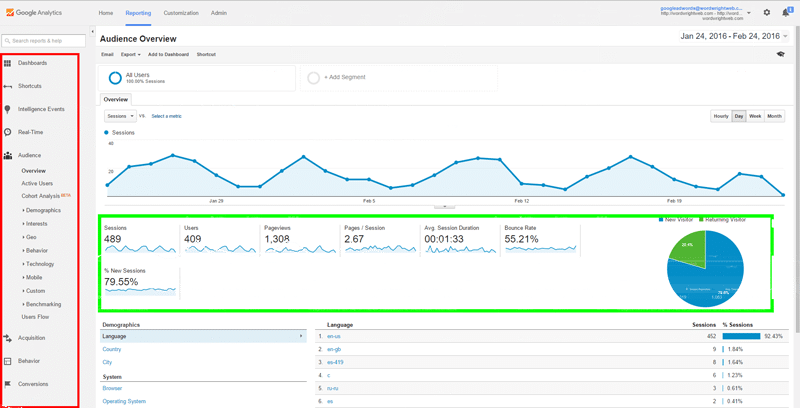
Getting more from your Google Analytics account
Understanding Google Analytics and using it to increase business
Ever logged into a Google Analytics account and been overwhelmed by the amount of information displayed? The dropdown menus all seem to display more and more. You may be digging deep and clicking on things but what does it all mean and how can you extract useful information from what you’re looking at?
Google Analytics dashboard – Bounce rate
First, understand the layout and the language within Google Analytics. The sidebar with dropdowns is outlined in red. This sidebar will unlock endless amounts of information, perhaps to the point of information overload. For now, we will focus on Bounce Rates and stay in the Audience section of the sidebar.
Finding the information
The area outlined in green is where you can get an overview of information. One number that may not be clear is the bounce rate. You may have heard the term but have no idea whether this is good, bad or why it matters.
Bounce rate is the percentage of people who get to a page on your site, don’t perform an action or look around and simply leave. After explaining bounce rate you’d probably be inclined to say a lower percentage would be better, and you’d be right!
What to do with this information
You’ve found the “what” part of the information; bounce rate is high. Next, find where high bounce rates occur. Let’s dive into the pages visitors are leaving quicker than we would like.
On the sidebar (red area) click the Behavior dropdown and Site Content sub menu. You should see a display with all of the pages within your domain name. Look at the 5th column on this view and you’ll see bounce rate (which should match the percentage under Audience). Chances are you have a few pages with a bounce rate of 70% or higher and this may include your home page. Take note of these pages; if you don’t trust your memory just write ‘em down.
Another good area to look at is the Exit Pages which will give more insight into the number of exits and the percentage of people who aren’t sticking around for very long.
Why is this happening?
For pages with high bounce rates you may look at the page itself. Pay attention to the load speed, the layout, the design and mainly the content. Chances are people are coming to this page in search of an answer or fulfillment of a need. If it takes too long to load, you’ve lost ‘em. The layout can be crucial as the eye is drawn to certain areas, which is why you often see images just off-center of the page. Your eye is more likely to skim and look for enticing items or aesthetically pleasing attributes. Keep in mind the design refers to the colors, fonts and other characteristics, not the organization of the page.
Content is usually the biggest issue. Lack of content or supporting content from the search result or another page on the site may be driving people away. If you have a specific product or service page with a high bounce rate, you should look to change the wording or organization. No one wants to read a book amount of text on a website. It doesn’t hurt to have it there but have bullet points or a short summary at the top of the page, perhaps with bookmarks to jump further down and get more detail.
Why should I care?
What’s the significance of a bounce rate anyway? Generally speaking, a lower bounce rate means you are better serving visitors the information they’re looking for. They see your website as a reliable source to gather relevant information that suits their needs. You’ll likely see a few more leads coming through when you can lower bounce rates of pages.
There’s also some SEO effects that can rub off. More content is seen as a good thing by Google, and making changes to the website means it is an active website – another plus. You can make use of keywords within the content to help as well. Lower bounce rates are seen to correlate with visitors getting relevant information and easily accessing that information. Google’s algorithm takes this into account so your website may begin to rank higher for certain search queries.
Updated: 10/26/2023
Categorised in: Search Engine Optimization
This post was written by admin



Comments are closed here.